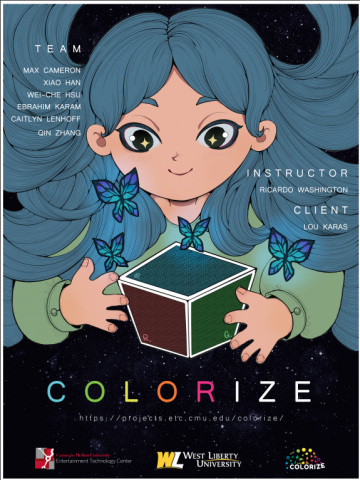Introduction
This week we focused on playtesting and iterating our activities . We went to West Liberty University on Monday, Feb 14 to playtest our activities with kids age K-8th grade. Then we iterated our activities based on the feedback and our observations. On Friday, Feb 18, we went to Marion Elementary School in Belle Vernon, PA to playtest again. On Wednesday, Feb 16, the team went to the Children’s Museum of Pittsburgh for team bonding, and we had a great experience together.

First Playtesting at West Liberty University
After meeting our client on Zoom for 4 weeks, the team has finally had a chance to visit our client at the Center for Arts and Education at West Liberty University, to playtest our activities. We were very excited to meet our client as well as the kids that were going to participate. We arrived at WLU at 10:30am. Lou provided us with a great space to set-up our activities and playtest with the kids. We set up 4 activity stations including 6 activities in total. Each station could support 2 kids playing at the same time.
- Shadow puppets station guided by Qin Zhang
- Whiteboard/hidden message station guided by Ebrahim Karam
- Tablet station, including color mixing and color matching games, guided by Caitlyn Lenhoff
- Arduino station, including interactive LED strip and “pluck a string” activity, guided by Wizard Wei-Che Hsu
*Xiao Han and Max Cameron would organize the flow of the playtest and take notes.
The students were divided into 3 groups: K-1, 2nd -3rd graders, and 4th graders or older. We met the younger students first and then the older ones. Overall, the kids really enjoyed our activities. Depending on their age, they would interact with the activities in different ways. For example, we found that kids in kindergarten really liked to make their own stories with the shadow puppets, whereas third graders would have more questions about the cross mixing of light. One thing that surprised us is how much fun the kids had with the arduino LED strip. This activity includes 3 buttons: red, green and blue, and it allows players to make secondary colors and white. Although most of the kids needed guidance to discover the color mixing part of the game, once they learned, they soon started to make their own games within the activities. They set goals such as making a rainbow or making a Christmas pattern and tried to achieve them. We also often see kids helping each other in this activity. Kids were very interested in the games on the tablets. They were especially attracted to the sound effects. When they were playing on the tablet, they would go back and forth between the two activities, using one as another’s reference.




After the playtest, Lou invited us to have lunch together at the University. While we were eating, we did a short debrief of the day and discussed the more specific directions that we would take for the future. Lou thought that the shadow puppet would be a great activity for teachers to replicate in class with simple equipment. The team would take that direction, make a list of things that could be easily purchased online and provide a guideline on how to replicate it.
Iteration
After the team went back to ETC, we had a meeting discussing the final form factors and how to iterate. We made several changes for Friday’s playtest, and we made a plan on how we further explore these activities in the future.
Changes we made for Friday:
- Arduino LED strip: Wizard increased the window of time that button presses registered which made it easier to press multiple buttons to create secondary colors.
- Software: Caitlyn fixed the volume of the activities. Previously, it was too loud.
Plan for the future
Shadow puppet
- Provide list of equipment and links to purchase
- Build 3 sets of shadow puppets of different theme, potentially plant, space and animals
- Put together a guideline including how to set up the activity and how to guide the players through
Arduino LED strip
- Brainstorm on how to bring a narrative or including more interesting theming elements to the game
Software
- Fabricate the hardware that has one board including two activities
- Potentially switching the color puzzle game to a game that asks kids to make a rainbow, using LED strips
Whiteboard/hidden message
- Look for the right hardware
- Provide a bigger whiteboard space that allows kids to write and draw.
Playing testing at Belle Vernon Elementary
On Friday, Feb 18, the team went to Marion Elementary School to test our activities. This time we brought 3 activities: Arduino LED strip, Software activities, and Whiteboard/Hidden message. We tested with 5 second grade students. Here are our takeaways:
- Kids were generally more shy and timid to play in a school environment
- Kids that were more extroverted tended to engage more with the activities.
- They generally needed guidance or guiding questions to figure out the activities.
- Kids would probably open up more if the adults were not present.

Team Bonding
On Wednesday, Feb 18, the team went to Children’s Museum of Pittsburgh together as a team bonding experience. We not only had fun, but were also inspired by the activities there that were designed for children. In the museum, we met an alumnus that works there who also graduated from ETC. They were very supportive and offered to let us use their space for future playtests.
Team Poster and Half Sheet.
Below is a poster and a half sheet made by our artist Qin Zhang.



Looking into next week
- Preparing halves presentation
- Practice the presentation with faculties.
